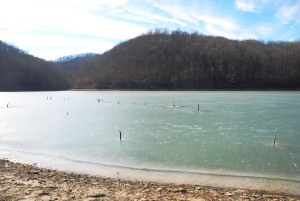By Chris Erwin
I went to the fish camp this past weekend. My plans were to try out some new lures that I have been prototyping. Next month is the month I build lures, fix fishing rods and generally get ready for spring.
Some of my friends wait on me to hit this period because once the season gets underway, I sell what extra lures I have. I don’t usually continue to make lures unless someone orders a bunch.
That said, I have been working on a couple of new models. The first step is to fashion the lures out of wood, then test them to see what alterations may be needed to get the exact action, buoyancy and size. Things like hook size and any other hardware that may be necessary are added at this time too. The point is to make a working lure exactly the way I want it. The next step is to convert that lure to plastic, so I can replicate each one to be exactly like the prototype.

This can be a long process from the drawing of my ideas, to the prototype, to the finished product. It usually takes me a full year. I will sometimes fish with the wood prototypes for a full season to make sure it produces and what line weights work the best with it.
There is one other little factor that must be accounted for too: Plastic has a little different buoyancy than wood meaning the lure may need to be a little lighter if the lure is to suspend or float.
I weigh each lure in grams making note of the exact weight because when I convert them to plastic, I need to make the plastic product to be the exact weight. I do this by adding either microblooms or tungsten to the plastic mixture.
This whole process starts when I take the wood prototypes to the water, usually in the middle of the winter, where I stand on the bank and test each one. I’m testing for how easy they cast so I can recommend what rig works best; spinning, casting, light, medium or medium heavy and what line weights are best.
I loaded all my gear on the ATV and headed for the water, once I rounded the first curve I could see the lake. The water seemed very still, usually I see the wind wave action. I dropped on over the hill and onto the open field near our American flag that can be seen from the water and once I was on the lower road the lake was in plain view.
The lake was frozen. I went on down to the water’s edge thinking there must be an open spot somewhere I can test my lures. I was wrong. There wasn’t anything open on the Popin Rock end of the lake. Edge to edge, the water was frozen.
I got off the ATV and picked up the biggest rock I could find. I figured I’d break open a spot large enough to test a few lures. I grabbed a rock with both hands — it was about the size of a 10-pound sack of potatoes — I spun around like a shot putter and hurled the rock as far out on the ice as possible.
The rock got good lift and went about 15 feet out over the ice and when it hit, I was expecting it to crash through with a splash. To my dismay, it thumped chipping up a little spot and then sliding about another two feet out onto the ice.
I repeated my throw three more times in different locations thinking I could find and hit a weak spot, but it just didn’t happen.
There would be no testing. I was on frozen ground!



Be the first to comment